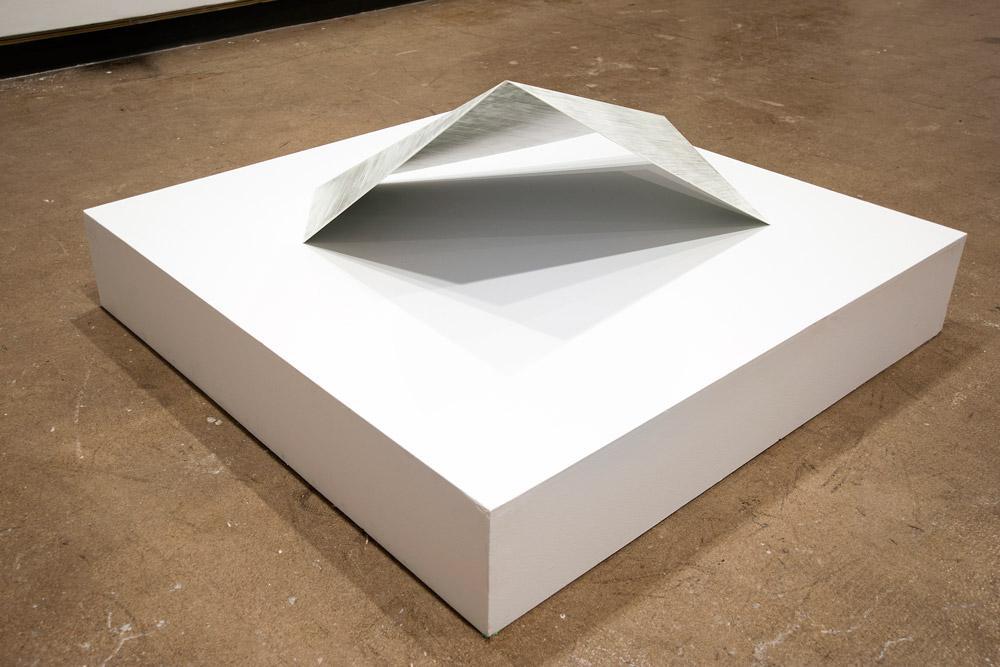This spring, a panel took place at Montreal’s Papier, where, following a discussion that framed its speakers by region, the conversation generously shifted into a rumination on what Canadian contemporary artists hold in common—nationally, generationally: generally. The panellists’ consensus was, more or less, that our country’s contemporary artists are still grappling with Modernism. An audience member even asked, somewhat exhaustedly, “When will we be done?”
Though this question went unanswered at “Who’s Afraid of Purple, Orange and Green?”—a perceptive and timely recent exhibition at the Dunlop Art Gallery—the show did suggest that we’ve reached a certain apex or concentration of interest in Modernism that might precede a diminishment.
There was, however, a twist to the project. Here, the “neo-Modern” was framed through a lens centred on female contemporary artists working in Canada. Eleven women (and one male, who works as part of a two-person collective, Marman and Borins) were showcased in the gallery’s diminutive space, where they took the room required to articulate various Modernist hereafters and frame their formalist homage in self-reflexive tones.
An agenda was also clear within the curatorial frame. Dunlop director/curator Jennifer Matotek launches an arrow in her essay’s opening paragraph, writing of Barnett Newman’s 1966 painting Who’s Afraid of Red, Yellow, and Blue? that it bears a “taunting title” and “a passive aggressive threat, veiled as a question.” She goes on to enumerate the Modernist era’s many masculinities (its language, its aesthetic, its critical reception) and even reaches into the field of semiotics, opining that Roland Barthes’s “death of the [male] author” left to female artists difficult questions deserving serious answers.
Matotek’s is an aggressive (or at the least, corrective) approach to a trend basically inherent to Canadian contemporary art. Our latest generation of artists are pursuing the language of Modernism, particularly its minimalist and formalist strains, and determinedly working to deconstruct its certainties through tactile media and reflexive gesture—and they aren’t uniquely women. However, given that all the prominent artists coming out of Emma Lake in the 1960s were men, Matotek’s desire to guerdon female artists 50 years later deserves its day.
The curator’s confrontational tone extended to the artists’ antagonisms of form. Krista Buecking anchored the exhibition with a central installation that performed its animus. WE THING (leverage island) (2012) presents a carpeted riser topped by a dominant red pyramid and a potted office plant. The arrangement goes accompanied by a looping video in which Buecking activates this environment, engaging in various forms of escapism and metaphysical querying, but rarely revealing her face. We become the inferred subject, asked to question our consumerism and conservative economies, while projecting ourselves into what is, despite its three dimensions, a flattened space.
Jessica Eaton—whose presence in the Canadian and US exhibition circuits has been abiding, in recent years—rarely gets shown for her subject matter, but rather for her technically rigorous and tenaciously analog process. But in this context, her three photographs are all about the content. Eaton’s deference to high Modernism’s repeated use of the cube and its perceived neutrality is destabilized by her infusion of additive and manipulated colour. Her cubes lift off the prints and hum like bells still ringing years after their first sounding.
Various artists—Sasha Pierce, Jennifer Rose Sciarrino, Luce Meunier—trouble the surface and play with scale. Pierce recalls Saskatchewan-born painter Agnes Martin (one of few iconic female Modernists, and also one of the few famed Modernists to arrive to the US from Canada), though works on a more modest scale. She meticulously hand-paints woven fabrics into a patchwork that, only from a distance, suggests its mathematical calculation. Meunier similarly introduces the hand’s mark into Modernist forms that, as Matotek aptly writes, formerly promoted a kind of “airlessness.” Sciarrino, meanwhile, packs her sculptures tight and pat, but their deceptive use of materials, and the way they implausibly inhabit space, produces a winking legerdemain. She undermines the scale, too, of so much heroic Modernist sculpture, nimbly positioning her forms between “model” and “monument.”
“Who’s Afraid of Purple, Yellow and Green?” unsettled aesthetic purities and pursued the unfinished business of perpetual returns. How long will we be plundering these gestures, and how far can we take our unravelling forms? Matotek invited female artists to present answers, not questions—though the exhibition still left a few dilemmas pending.









